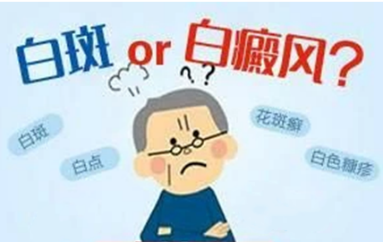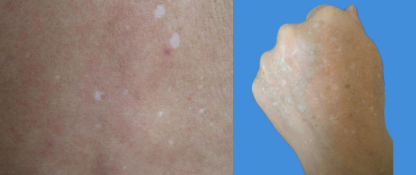[Micro Popular Science] Senile Leukoplakia
With the growth of age, some elderly people suddenly found their arms, chest, back there are some small circular white spots, they are very anxious, God, how old also got vitiligo? So they rushed to dermatology, the doctor told them not to be nervous, not vitiligo, but senile leukoplakia.

What is senile leukoplakia?
Senile leukoplakia is a kind of senile skin degeneration, mainly manifested by the appearance of round or oval white spots on the skin. It is a common skin phenomenon that usually appears in middle-aged and elderly people.
Why does senile white spot appear?
The main reason is skin aging. With age, the function of melanocytes in the skin gradually declines. Melanocytes are the cells that produce melanin, which gives skin its color and protects it from UV damage. When the function of melanocytes decreases, the ability to produce melanin also decreases, resulting in local skin whitening.
What are the manifestations of senile white spots?
Old white spots are usually round or oval white spots with clear boundaries. They vary in size, generally ranging from a few millimeters to a few centimeters in diameter. The color of the spots is mostly porcelain white or milky white, and the surrounding normal skin contrast is obvious. They can occur singly or in multiple scattered locations, most commonly in the chest, back, abdomen and other trunk, as well as the proximal extremities.

How to identify with vitiligo and other white spots?
The diagnosis of senile leukoplakia is mainly based on the age of the patient (usually over 50 years old) and the typical characteristics of leukoplakia (such as shape, color, distribution, skin texture, etc.). In general, when white spots with clear boundaries and normal texture are seen on the skin, and the age of the patient is consistent with the age range of the onset of senile leukoplakia, the possibility of senile leukoplakia is first considered.
It needs to be differentiated from vitiligo. Vitiligo can occur at any age, the size and shape of the white spot can be irregular, the boundary can be blurred or clear, and the hair within the white spot can also become white. And the white spots of vitiligo may gradually expand or fuse. The old white spots are usually relatively stable, the size and shape are relatively regular, and the hair is generally unchanged.
It should also be identified with tinea versicolor. Tinea versicolor is a skin disease caused by Malassezia bacteria. It is characterized by light brown, light red or white patches with small scales on the surface. It tends to occur in sweaty areas such as the chest and back. It can be identified by a fungal examination. Tinea versicolor can be seen under a microscope.
Does senile leukoplakia need treatment?
Old age leukoplakia usually does not cause serious health effects and generally does not require special treatment. But pay attention to the daily care of the skin, avoid excessive exposure to the sun. Because the skin in the white spot lacks the protection of melanin, it is more sensitive to ultraviolet light and vulnerable to damage. Sun protection measures such as umbrellas and hats can be used.
Some patients may experience psychological stress due to changes in appearance. For such patients, families and medical staff should give psychological support to let them understand that white spots in old age is a normal aging phenomenon and relieve their anxiety.
If the patient is more concerned about the appearance of white spots, masking agents can be used to temporarily improve the appearance. Masking agents are similar to cosmetics and can cover white spots, making them similar in color to the surrounding skin. For some patients with cosmetic needs, laser treatment can also be considered. Such as excimer laser, it can stimulate the activity of melanocytes and promote the synthesis of melanin. However, the effectiveness of this treatment varies from individual to individual and may require multiple treatments.
Can senile leukoplakia be prevented?
Paying attention to skin care and maintaining the health of the skin can delay skin aging to a certain extent, thereby preventing the appearance of white spots. The elderly should use mild cleaning products to clean their skin and avoid harsh soaps. Apply moisturizer immediately after cleansing to retain skin moisture and enhance skin barrier function.
At the same time, pay attention to nutritional supplements, appropriate supplementation of antioxidants, such as vitamin C, vitamin E and so on. These antioxidants can help rid the body of free radicals and reduce oxidative stress damage to melanocytes.
In addition, minimize skin exposure to harmful chemicals, such as hair dye, hair perm and other chemicals may have adverse effects on the skin. Avoid skin trauma, which may affect local skin blood circulation and melanocyte function.
Li Weiran, the First Affiliated Hospital of Anhui Medical University
Young member of Dermatology Branch of Chinese Geriatric Society
(The opinions expressed are solely those of the author. Some pictures in this article are from the Internet, if there is infringement, contact delete)

